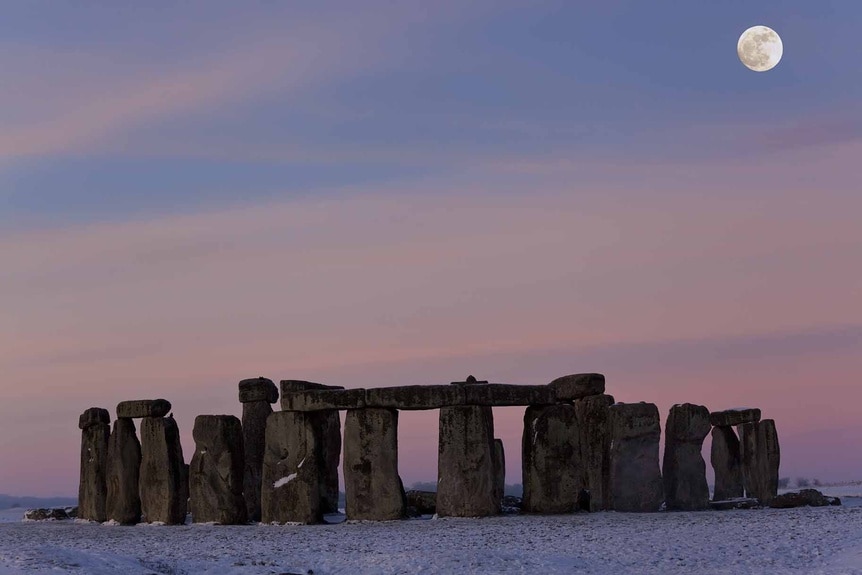Create a free profile to get unlimited access to exclusive videos, sweepstakes, and more!
Shining Moonlight on the Mystery of Stonehenge
Ancient Europeans tracked the Sun and the Moon at Stonehenge.
When viewers were first introduced to the Sharknado franchise it was a wholly natural (if bizarre) weather phenomenon. The combination of a Pacific hurricane and a series of twisters lifted a school of toothy fish into the air, creating the titular sharknado. By the time we reached the fifth installment, Sharknado 5: Global Swarming, things had taken a decidedly supernatural turn.
With the sharknado phenomenon escalating and spreading around the globe, Fin and April (Ian Ziering and Tara Reid) travel with their son to London, where a NATO meeting is scheduled to address the ongoing threat. While in the area, they discover an ancient sharky temple underneath the famed Stonehenge structure.
While the real-world Stonehenge won’t summon an aerial army of sharks, it has been associated with celestial activities and annual weather patterns throughout its history. Now, scientists believe they may have uncovered a new feature of the structure, tracking the arrival of a lunar standstill, once every 18.6 years.
For More on the Moon:
Remembering Apollo Astronaut William Anders and His Famous Earthrise Photo
A Lunar "Wall of Death": How Astronauts Could Keep Fit on the Moon
What Are the Moon Phases and How Do They Work?
Does Stonehenge Mark the Lunar Standstill Every 18.6 Years?
While the name suggests a Moon frozen in place, a lunar standstill (otherwise known as a lunistice) is when the Moon reaches its farthest north and farthest south points on the horizon, during the course of a single month.
The Moon’s position and appearance in the sky at any given time is the result of the movements of the Earth-Moon-Sun system. The combination of the Earth’s angle and the orbits of the Earth and Moon cause subtle variations in when and where the Moon rises and sets. As a result, the Moon’s angle across the sky shifts along an 18.6-year cycle, punctuated by a lunar standstill.
This periodic motion of the Moon would have caught the attention of ancient peoples, who were tied into the celestial motions and their relationship with the seasons. Some of those people then built megastructures which were apparently designed to track those motions. Stonehenge was built by Neolithic and Bronze Age Europeans over the course of 1,500 years, beginning in 3,000 B.C. The construction required the collection, transport, and meticulous arrangement of dozens of massive stones. It was no easy job, so it must have been important.
The precise purpose (or purposes) of Stonehenge is still the subject of debate, but over the last couple of centuries scientists have come up with a few ideas. They noticed that the entrance to the complex faces the rising Sun on the day of the summer solstice. That’s unlikely to be a coincidence and led to the belief that Stonehenge serves as a solar calendar. New research, however, suggests that Stonehenge also tracks the motions of the Moon, as evidenced by the alignment of some stones with the lunar standstill.
The most recent major lunar standstill just happened, and scientists were on site at Stonehenge to see how the stones and the sky lined up. In the deep past, when Stonehenge was complete, there were four station stones forming the corners of a rectangle that surrounds the stone circle. Only two of those station stones remain today, but during a lunar standstill, the Moonrise and Moonset line up with them.
Researchers suggest that for early farmers, the motions of the sky would have been an important way of tracking the seasons. The arrival and departure of the Moon each night would have provided light by which to work and hunt in the dark. Showing up farther along the horizon once every couple of decades seems to have been notable enough to include the phenomenon in their construction plans. There is also evidence of cremated human remains buried at the site and associated with the station stones.
While Stonehenge is a monument to early science, math, and engineering, it was likely also of spiritual importance to the people who made it. Some researchers have even suggested that the lunar standstill may have been a time when the god of the Moon was at the height of its power. For now, the cultural and spiritual meanings of the monument, much like the practical applications, remain mostly lost to time.
Stonehenge might still be a mystery, but you can unravel the truth behind the Sharknado film franchise in Sharknado: Feeding Frenzy, streaming now on Peacock.































